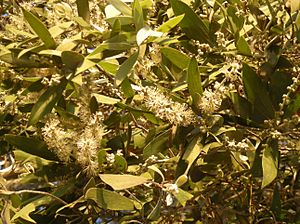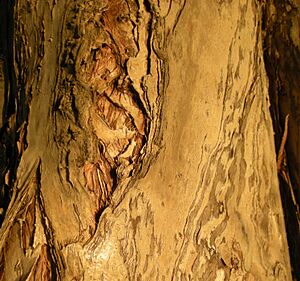Karnbor facts for kids
Quick facts for kids Karnbor |
|
|---|---|
 |
|
| M. dealbata foliage and flowers. | |
| Scientific classification | |
| Genus: |
Melaleuca
|
| Species: |
dealbata
|
The Melaleuca dealbata, often called karnbor or blue paperbark, is a special plant. It belongs to the myrtle family, called Myrtaceae. This tree grows naturally in warm, tropical places like northern Australia, New Guinea, and Indonesia. It's a medium to large tree with lots of leaves. You'll often find it in wet areas, such as near coastal lagoons. It has unique papery bark, blue-green leaves, and pretty cream-colored flowers that bloom for a long time.
Contents
What Does Karnbor Look Like?
The Karnbor tree, or Melaleuca dealbata, grows slowly and can reach about 25 m (80 ft) tall. It has cool blue-grey leaves and branches that hang down a bit. Its bark is papery and grows in many layers.
The leaves grow one after another along the branches. They are shaped like an oval, about 50–126 mm (2–5 in) long and 10–30 mm (0.4–1 in) wide. You can see five to seven clear lines running along the length of each leaf. Young shoots and twigs are covered in soft, white or silver hairs.
The flowers are small and creamy-white. They grow in groups of three on spikes that can be up to 120 mm (5 in) long and 25 mm (1 in) wide. Each flower has five groups of stamens, which are the parts that make pollen. There are 5 to 8 stamens in each group.
Karnbor trees usually flower from May to December, but mostly in spring. After the flowers, the tree grows woody, cup-shaped fruits called capsules. These are about 2.5–3.5 mm (0.098–0.14 in) wide and long. When the fruit is ready, tiny, sawdust-like seeds are released.
How Karnbor Got Its Name
The scientific name Melaleuca dealbata was first officially written down in 1968 by a scientist named S.T. Blake. The second part of its name, dealbata, comes from a Latin word. It means "covered with a white powder," which might describe the look of its young shoots.
This tree has many common names! People call it karnbor, swamp tea-tree, soapy tea-tree, blue-leaved paperbark, blue paperbark, honey tree, and cloudy tea-tree.
Where Karnbor Lives
Karnbor trees grow in many places. You can find them in southern Papua New Guinea, Irian Jaya in Indonesia, and across northern Australia. In Australia, they grow from north of Maryborough in Queensland, all the way through north Queensland, to the Top End of the Northern Territory. They also grow in the Broome-Derby area and the Weaber Range in the eastern Kimberley region of Western Australia.
These trees like warm, humid places where it doesn't get frosty. They usually grow where the average yearly rainfall is about 1,100–1,750 mm (43–69 in), mostly in summer. You'll often see them in swampy areas near the coast or further inland. They like wet spots along stream banks, in seasonally flooded ground, and at the edges of lagoons. They can grow in different types of soil, from sand to clay.
Karnbor and Its Animal Friends
The flowers of the Karnbor tree are full of sweet nectar. This makes them very popular with different animals! Parrots, honeyeaters (a type of bird), flying foxes (a kind of bat), and possums all love to visit these trees for a tasty treat.
How People Use Karnbor
The wood from the Melaleuca dealbata tree is quite heavy and very strong. This means it could be used to make things like posts and poles.
This tree is also very pretty and helpful for the environment. It can be planted to create shelterbelts, which are rows of trees that protect areas from wind. It also helps to keep soil from washing away. In northern Australia, it has been used to help bring life back to areas where bauxite (a type of rock) was mined.
Because its flowers produce so much nectar, the Karnbor tree is an excellent source for making honey. Scientists have also studied the tree's oil. They found it produces a small amount of essential oil, which has different natural chemicals in it.


